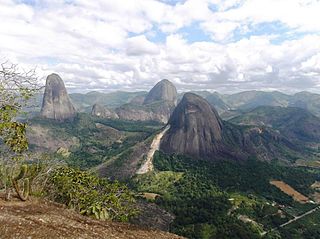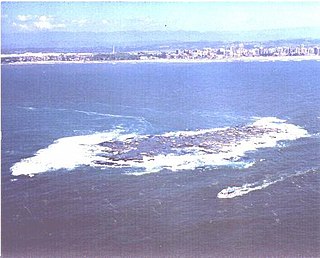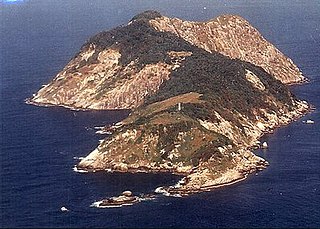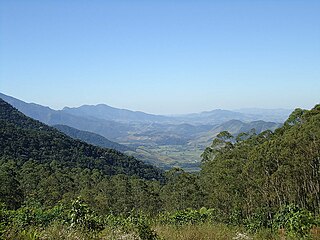
A Natural Monument (Portuguese : Monumento natural) in Brazil is a type of protected area of Brazil. They are created by law. The purpose of a natural monument is to conserve unique or very beautiful natural sites.

A Natural Monument (Portuguese : Monumento natural) in Brazil is a type of protected area of Brazil. They are created by law. The purpose of a natural monument is to conserve unique or very beautiful natural sites.
The Natural Monument class of conservation unit was defined by the law 19/93 of 23 January 1993. [1] This basic objective of this type of unit is to preserve natural sites that are unique and/or have great scenic beauty. They may be private property as long as the owner's use is compatible with the objectives. If not, the area is expropriated. The public may visit the natural monuments, and research may be conducted with permission of the responsible agency. [2]
| Name | Level | State | Created | Area (ha) |
|---|---|---|---|---|
| Beberibe Cliffs | State | Ceará | 2004 | 31.2 |
| Capão da Amizade | Municipal | Rio Grande do Sul | 2009 | 1.3 |
| Falésias de Marataízes | Municipal | Espírito Santo | 2008 | 42.14 |
| Ferro Doido Waterfall | State | Bahia | 1998 | 362.09 |
| Frade e a Freira | State | Espírito Santo | 2007 | 861 |
| Grota do Angico | State | Sergipe | 2007 | 2,183 |
| Gruta do Lago Azul | Federal | Mato Grosso do Sul | 1978 | 263 |
| Ilhas Cagarras | Federal | Rio de Janeiro | 2010 | 523 |
| Itabira | Municipal | Espírito Santo | 1988 | 450 |
| Lancinhas | State | Paraná | 2006 | 164 |
| Morro da Pedreira Caves | State | Federal District | 2010 | 90.7 |
| Morro do Penedo | Municipal | Espírito Santo | 2007 | 18.79 |
| Morro de Santo Antônio | State | Mato Grosso | 2006 | 258 |
| Morros do Pão de Açúcar e Urca | Municipal | Rio de Janeiro | 2006 | 91.48 |
| Pedra Grande | State | São Paulo | 2010 | 3,297.01 |
| Pedra das Flores | Municipal | Rio de Janeiro | 2005 | 346 |
| Pedra do Baú | State | São Paulo | 2010 | 3,154 |
| Pedra do Colégio | Municipal | Rio de Janeiro | 2010 | 127 |
| Pedra do Elefante | Municipal | Rio de Janeiro | 2010 | 530 |
| Peter Lund | State | Minas Gerais | 2005 | 73 |
| Pontões Capixabas | Federal | Espírito Santo | 2002 | 17,443 |
| Quixadá Monoliths | State | Ceará | 2002 | 16,635 |
| Rio Formoso | State | Mato Grosso do Sul | 2003 | 18 |
| Rio São Francisco | Federal | Alagoas, Bahia, Sergipe | 2009 | 26,736 |
| Serra das Torres | State | Espírito Santo | 2010 | 10,458.90 |
| Sugarloaf Mountain and Urca Hill | Municipal | Rio de Janeiro | 2006 | 91.5 |
| Subaé Canyons | State | Bahia | 2006 | 404 |
| Tocantins Fossil Trees (Árvores Fossilizadas) | State | Tocantins | 2000 | 32,152 |
| Valley of the Dinosaurs | Municipal | Paraíba | 2002 | 40 |

Protected areas of Brazil included various classes of area according to the National System of Conservation Units (SNUC), a formal, unified system for federal, state and municipal parks created in 2000.

The Cabo Orange National Park is a National park located in Amapá state in the north of Brazil, near the border between Brazil and French Guiana.

Pontões Capixabas Natural Monument is a natural monument in the state of Espírito Santo, Brazil.

Saint-Hilaire/Lange National Park is a national park in Paraná, Brazil.
Comboios Biological Reserve is a biological reserve in the state of Espírito Santo, Brazil.

Anavilhanas National Park is a national park that encompasses a huge river archipelago in the Rio Negro in the state of Amazonas, Brazil. It is part of a World Heritage Site.

Guaraqueçaba Ecological Station is an ecological station in the municipality of Guaraqueçaba, Paraná, Brazil.

Guaraqueçaba Environmental Protection Area is a protected area in the State of Paraná, Brazil. It includes Atlantic Forest, mangrove, salt marsh and estuarine environments in an area with a relatively low human population.

A Wildlife refuge in Brazil is a type of strictly protected area of Brazil defined by law. The purpose of the wildlife refuge is to ensure survival or reproduction of a species or community of flora or fauna, with access rules defined by the administrative agency.

A biological reserve in Brazil is a legally defined type of protected area of Brazil, a conservation unit that aims for full preservation of biota and other natural attributes without human interference. It may be visited only with prior approval of the responsible agency, and only for research or educational purposes.

An area of relevant ecological interest is a type of protected area of Brazil with unusual natural features and with little or no human occupation.
Buriti de Vassununga Area of Relevant Ecological Interest is an area of relevant ecological interest, a sustainable use protected area, in the state of São Paulo, Brazil.
The Rio São Francisco Natural Monument is a natural monument in the states of Alagoas, Bahia and Sergipe, Brazil. It protects a section of dramatic canyons on the São Francisco River and the surrounding caatinga environment, while supporting tourism and ecotourism.

Mapinguari National Park is a national park in the states of Rondônia and Amazonas, Brazil. It covers a large area of Amazon rainforest. The boundaries have been adjusted several times.

The Amapá National Forest is a national forest in the state of Amapá, Brazil. It supports sustainable exploitation of the natural resources in an area of Amazon rainforest in the Guiana Shield.

The Mantiqueira Mosaic is a protected area mosaic that contains conservation units in the states of Rio de Janeiro, São Paulo and Minas Gerais, Brazil. The conservation units are of different types and are managed at the federal, state or municipal level. The mosaic provides a level of integrated and coordinated management.
The Pedra das Flores Natural Monument is a municipal natural monument in the state of Rio de Janeiro, Brazil.

The Rio dos Frades Wildlife Refuge is a wildlife refuge in the state of Bahia, Brazil. It protects the land around the mouth of the Frades River. There is pressure, or opportunity, to develop the reserve for tourism.
The Santa Cruz Wildlife Refuge is a wildlife refuge in the state of Espírito Santo, Brazil.
The Serra das Torres Natural Monument is a natural monument in the state of Espírito Santo, Brazil. It protects the peaks of a mountain range in the south of the state.